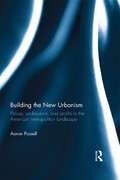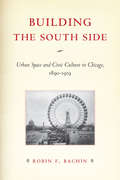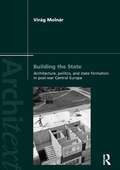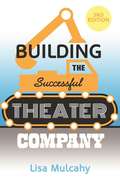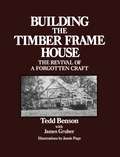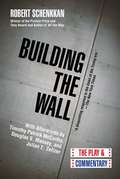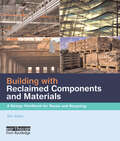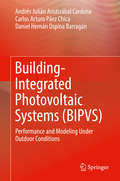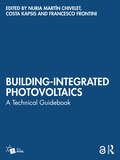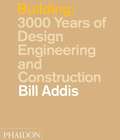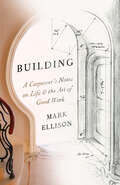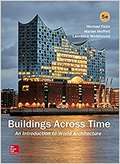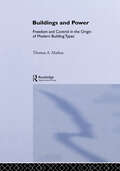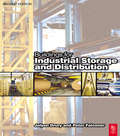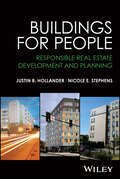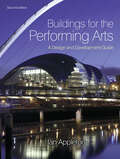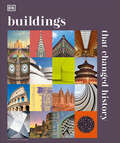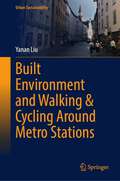- Table View
- List View
Building the New Urbanism: Places, Professions, and Profits in the American Metropolitan Landscape
by Aaron PassellThe New Urbanism is perhaps the most influential movement that has emerged in suburban design, planning, and development in recent decades. It proposes to reform conventional suburban development by "building community." Building the New Urbanism asks "why new urbanism now?" to provide the first in-depth sociological investigation of the emergence of this phenomenon. This volume situates the growth of New Urbanism in the history of urban and suburban policy and development. The book builds an account of the movement’s founding and development, linking its progress to the making of new places. The volume also investigates how the movement capitalized upon dynamics within architecture, planning, and the homebuying public to recruit support from among those groups. The book establishes a framework for analyzing the opportunities and constraints that confront any effort to change the way we produce the built environment. Moreover, it reveals how elaborately social the production of the built environment is and how specific the material solutions to social conditions must be to resolve this process. Building the New Urbanism is an accessible volume that encapsulates and engages the dominant history of American suburbia. It draws on interviews with key figures, brings the work of prominent theorists of culture and science into the investigation, and broadens the focus of urban studies to the metropolitan region. It will be of particular interest to scholars and students of urban and suburban development, sociology, geography, and planning.
Building the Perfect Tool Chest
by Jim StackBuild the tool chest of your dreams!Why spend money on prepackaged tool boxes when you can make something better from scratch - a tool box tailored to your specific needs?In Building the Perfect Tool Chest, master craftsman Jim Stack provides complete materials lists, plans and step-by-step instructions for building 15 stylish, yet practical, designs. Perfect for hand tools and power tools alike, projects range from elegant rolling cabinets to utilitarian tote boxes - a selection that ensures something for every woodworker, no matter what your level of skill.It's all the guidance you need to craft the tool chest design you've been dreaming of - classic, contemporary or uniquely your own!Projects include:Handy boxSmall tool chestTool caddyTen-drawer chestJim's toolboxRolling tool cabinetCabinetmaker's chestJourneyman's tote boxSliding-door cabinetPlane cabinet & casePegboard-lover's cabinetFly-tying boxSouthwestern chestCurved-front chest21st-century tool cabinet
Building the South Side: Urban Space and Civic Culture in Chicago, 1890-1919
by Robin F. BachinBuilding the South Side explores the struggle for influence that dominated the planning and development of Chicago's South Side during the Progressive Era. Robin F. Bachin examines the early days of the University of Chicago, Chicago's public parks, Comiskey Park, and the Black Belt to consider how community leaders looked to the physical design of the city to shape its culture and promote civic interaction. Bachin highlights how the creation of a local terrain of civic culture was a contested process, with the battle for cultural authority transforming urban politics and blurring the line between private and public space. In the process, universities, parks and playgrounds, and commercial entertainment districts emerged as alternative arenas of civic engagement.
Building the State: Architecture, Politics, and State Formation in Postwar Central Europe (Architext)
by Virag MolnarThe built environment of former socialist countries is often deemed uniform and drab, an apt reflection of a repressive regime. Building the State peeks behind the grey façade to reveal a colourful struggle over competing meanings of the nation, Europe, modernity and the past in a divided continent. Examining how social change is closely intertwined with transformations of the built environment, this volume focuses on the relationship between architecture and state politics in postwar Central Europe using examples from Hungary and Germany. Built around four case studies, the book traces how architecture was politically mobilized in the service of social change, first in socialist modernization programs and then in the postsocialist transition. Building the State does not only offer a comprehensive survey of the diverse political uses of architecture in postwar Central Europe but is the first book to explore how transformations of the built environment can offer a lens into broader processes of state formation and social change.
Building the Successful Theater Company
by Lisa MulcahyWhat makes a theater company successful? Lisa Mulcahy poses the question to leaders from nineteen of the country’s most diverse and vital theater companies from the recent past and present, and offers answers in Building the Successful Theater Company. Producers, stage managers, directors-anyone dreaming of running a theater troupe-will benefit from the practical guidance, amusing anecdotes, and sincere advice in this peek behind the curtains of the often difficult, always seductive, profession of theater. With five additional companies profiled in this fully revised third edition, Building a Successful Theater Company features: The LABrynth Theater Company New Paradise Laboratories National Theatre of the Deaf Shotgun Players Asian-American Theatre Company Steppenwolf Theater Company The Pasadena Playhouse La Jolla Playhouse Chicago City Limits Berkeley Repertory Theatre Arena Stage’s The Living Stage Theatre Company Mixed Blood Theatre Company Horizons Theatre Wheelock Family Theatre L.A. Theatre Works A Traveling Jewish Theatre Jean Cocteau Repertory Bailiwick Repertory New Repertory TheatreNew chapters cover funding and financial aspects, maximizing a company's potential through powerful social media use, and creating successful partnerships by teaming up with corporate sponsors and establishing artistic collaborations. Stage veterans reveal advice on everything from locating performance space, to developing a business plan, to and rehearsing and publicizing productions in this invaluable guide to creating or growing a theater company.Allworth Press, an imprint of Skyhorse Publishing, publishes a broad range of books on the visual and performing arts, with emphasis on the business of art. Our titles cover subjects such as graphic design, theater, branding, fine art, photography, interior design, writing, acting, film, how to start careers, business and legal forms, business practices, and more. While we don't aspire to publish a New York Times bestseller or a national bestseller, we are deeply committed to quality books that help creative professionals succeed and thrive. We often publish in areas overlooked by other publishers and welcome the author whose expertise can help our audience of readers.
Building the Successful Theater Company
by Lisa MulcahyThe second edition of Building the Successful Theater Company takes readers even deeper into the world of theatrical production, examining in great depth the financial realities of establishing--and maintaining--a successful organization. This indispensable reference is updated to include more theater company profiles with expert advice to better reveal the pitfalls, passions, and practicalities of the theater industry. The author's been-there-done-that personal experiences along with the wisdom of esteemed theater company heads will encourage readers to aim high and overcome challenges to accomplish all of their creative and financial objectives. Everything from finding a performance space, to creating a first season, to promoting a company and production, to designing a long-term plan is discussed in detail in this engaging guide--a sometimes irreverent, always relevant look behind the curtain of the modern stage troupe. Chapters include developing business and budget plans, rehearsing, attracting attention with publicity and word-of-mouth, adapting to growth, and more. No other book contains the unique insights and sound advice found in this indispensable reference.
Building the Timber Frame House: The Revival of a Forgotten Craft
by Tedd BensonFor centuries, post-and-beam construction has proved to be one of the most durable building techniques. It is being enthusiastically revived today not only for its sturdiness but because it can be easily insulated, it is attractive, and it offers the builder the unique satisfaction of working with timbers. Building the Timber Frame House is the most comprehensive manual available on the technique. In it you will find a short history, of timber framing and a fully illustrated discussion of the different kinds of joinery, assembly of timbers, and raising of the frame. There are also detailed sections on present-day design and materials, house plans, site development, foundation laying, insulation, tools, and methods.
Building the Wall: The Play and Commentary (Oberon Modern Plays Ser.)
by Julian E. Zelizer Douglas S. Massey Robert Schenkkan Timothy Patrick McCarthyIn the tradition of Hamilton and Angels in America, a powerful, politically charged, dystopian drama that couldn’t be more timely. Written in a “white-hot fury” on the eve of the 2016 election, the stunning new play by Pulitzer Prize– and Tony Award–winning dramatist Robert Schenkkan is creating a nationwide sensation. Bypassing the usual development path for plays, it has been signed up to open in five theaters across America in a National New Play Network Rolling World Premiere, starting in Los Angeles (March) and Denver (April) and continuing in the Washington, DC, area, Tucson, and Miami, with more productions to follow, including in Santa Fe and New York City. Building the Wall lays out in a harrowing drama the consequences of Donald Trump’s anti-immigration campaign rhetoric turned into federal policy. Two years from now, that policy has resulted in the mass round-up of millions of illegal aliens, with their incarceration overflowing into private prisons and camps reminiscent of another century. The former warden for one facility is awaiting sentencing for what happened under his watch. In a riveting interview with a historian who has come seeking the truth, he gradually reveals how the unthinkable became the inevitable, and the faceless illegals under his charge became the face of tragedy. The play is accompanied by commentary from three prominent scholars: on the real purpose of the border wall, our dark nativist history of restricting immigration, and the tradition of political protest in art.
Building with Reclaimed Components and Materials: A Design Handbook for Reuse and Recycling
by Bill AddisInterest in green and sustainable design is growing throughout the world. Both national and local governments are active in promoting reuse and recycling in order to reduce the amount of waste going to landfill. This guide identifies how building designers and constructors can minimize the generation of waste at the design stage of a building project by using reclaimed components and materials. Authoritative, accessible and much-needed, this book highlights the opportunities for using reclaimed components and materials and recycled-content building products for each element of a building, from structure and foundations to building services and external works. Current experience is illustrated with international case studies and practical advice. It discusses different approaches to designing with recycling in mind, and identifies the key issues to address when specifying reclaimed components and recycled materials in construction work. This book will be invaluable for building professionals � including architects, specifiers, structural and service engineers, quantity surveyors, contractors and facilities managers � as well as students of architecture and civil engineering. Published with NEF
Building-Integrated Photovoltaic Systems (BIPVS)
by Andrés Julián Aristizábal Cardona Carlos Arturo Páez Chica Daniel Hernán Ospina BarragánThis book discusses building-integrated photovoltaic systems (BIPV) and provides solutions for solving problems related to designing, sizing and monitoring a BIPV that has been used to replace conventional building materials in parts of the building envelope such as the roof, skylights or facades. The book begins by introducing the basics to readers interested in learning about this technology and then outlines in an accessible way, a practical development plan for the installation and monitoring of these systems in residential, industrial, and commercial buildings. Chapters discuss the needs of installing, designing, and sizing and provide a financial analysis for a successful implementation of a BIPV system. This book is a useful tool for renewable energy designers, energy contractors, architects, government institutions, and those in the academic community who are interested in seamlessly integrating solar panels into the construction phase of new building projects or retrofitted into existing buildings.
Building-Integrated Photovoltaics: A Technical Guidebook
by Nuria Martín Chivelet Costa Kapsis Francesco FrontiniBuilding-integrated photovoltaics (BIPV) is an innovative technology offering a variety of building envelope solutions, materials, and colours for virtually any building surface. These BIPV products generate on-site renewable electricity, turning buildings from energy consumers to producers. BIPV is expected to play an indispensable role in the transition towards decarbonisation and energy resilience of cities, effectively reducing energy consumption and greenhouse gas emissions. Lack of knowledge and guidance on designing BIPV systems has hindered this technology's widespread adoption and creative applications. As a remedy, this guidebook presents best practices and decision-making processes for efficient and resilient architecture. Featuring more than 50 annotated reference drawings—roofs, solar shadings, rainscreen façades, curtain walls and double skin façades—and 24 international BIPV case studies, the guidebook provides building professionals with the technical knowledge and inspiration to implement BIPV technology in the built environment.
Building: 3,000 Years of Design, Engineering and Construction
by Bill AddisCambridge International AS and A Level Business Studies Revision Guide has been designed to help students prepare for Cambridge International AS and A Level Business Studies (9707) examinations. Written in an easy-to-follow style, the book helps in reinforcing students' understanding and provides guidance on revision.
Building: A Carpenter's Notes on Life & the Art of Good Work
by Mark EllisonA visionary carpenter shares indelible stories on building a life worth living, revealing powerful lessons about work, creativity, and design through his experience constructing some of New York&’s most iconic spaces.For forty years, Mark Ellison has worked in the most beautiful homes you&’ve never seen, specializing in rarefied, lavish, and challenging projects for the most demanding of clients. He built a staircase that the architect Santiago Calatrava called a masterpiece. He constructed the sculpted core of Sky House, which Interior Design named &“Apartment of the Decade.&” His projects have included the homes of David Bowie, Robin Williams, and others whose names he cannot reveal. He is regarded by many as the best carpenter in New York.Building: A Carpenter&’s Notes on Life & the Art of Good Work tells the story of an unconventional education and how fulfillment can be found in doing something well for decades. Ellison takes us on a tour of the lofts, penthouses, and townhomes of New York&’s elite, before they&’re camera-ready. In a singular voice, he offers a window into learning to live meaningfully along the way. From staircases that would be deadly if built as designed and algae-eating snails boiled to escargot in a penthouse pond, to the deceptive complexity of minimalist design, Building exposes the tangled wiring, scrapped blueprints, and outlandish demands that characterize life in the high-stakes world of luxury construction.Blending Ellison&’s musings on work and creativity with immersive storytelling and original sketches, photos, and illustrations, Building is a meditation on crafting a life worth living, and a delightful philosophical inquiry beyond the facades that we all live behind.
Buildings Across Time: An Introduction to World Architecture
by Michael Fazio Marian Moffett Lawrence Wodehouse<p>Now in its fifth edition, Builds across Time brilliantly explores the essential attributes of architecture by uniquely combining both a detailed survey of western architecture, including Pre-Columbian America, and an introduction to architecture from the Middle East, India, Russia, China, and Japan. This latest edition includes over 450 new photos, a new essay on the vision of Pope Pius II, and updates on building in various parts of the world, such as those that have been given new purpose and those that have been damaged by ISIS. <p>Written in a clear and engaging style, the text encourages readers to examine closely in photographs and line drawings the pragmatic, innovative, and aesthetic attributes of buildings, and to imagine how these would have been praised or criticized by contemporary observers. Architecture is discussed in various contexts - artistic, economic, environmental, political, social, and technological - so as to determine the extent to which buildings met the needs of clients, society at large, and future generations. </p>
Buildings Inspired by Nature (Fountas & Pinnell Classroom, Guided Reading Grade 5)
by Lisa LernerLearning from Nature When it comes to solving problems, the natural world has a lot to teach us. Architects today are looking closely at plants and animals to design some incredible buildings. NIMAC-sourced textbook
Buildings That Breathe: Greening the World's Cities
by Nancy F. CastaldoImagine looking out from your 18th floor apartment in the middle of the city and seeing trees right in front of you. In an effort to stem climate change, reduce pollution, combat heat, and protect biodiversity, architects are teaming up with botanists, urban wildlife ecologists, and other scientists to design high-rise forests, living walls, and vertical farms in some of the world’s most populated places. These projects are happening all around the world, and they will not only change the urban landscape, but they will provide urban dwellers with a healthier place to live and work. For Buildings That Breathe, author and environmental journalist Nancy Castaldo connected with architect Stefano Boeri at the World Forum on Urban Forests and was invited to his office in Milan where she visited Bosco Verticale, the first high-rise forest. Planted with 750 trees, 5,000 shrubs, and 11 perennials on two apartment towers, the project provides an urban habitat for birds, insects, and people while creating a micro-climate that produces oxygen and provides shade for high-rise residents. Explore Bosco Verticale, as well the planned Liuzhou Forest City in China and other green architecture projects around the world, looking at how people are working together to change the urban landscape of the future.
Buildings That Make You Think (Fountas & Pinnell Classroom, Guided Reading)
by Laura SalasNIMAC-sourced textbook. ONE-OF-A-KIND BUILDINGS. A building might be an office or a museum. It might be a house or a hotel. But can a building make you think about art?
Buildings Used: Human Interactions with Architecture (Routledge Research in Architecture)
by Nora Lefa Pavlos LefasBuildings Used takes the reader on an exploration into the impact of use on buildings and users. While most histories and theories of architecture focus on a building’s conception, design, and realization, this book argues that its identity is formed after its completion through use; and that the cultural and psychological effects of its use on those inhabiting it are profound. Across eight investigative chapters, authors Nora Lefa and Pavlos Lefas propose that use should not be understood merely as function. Instead, this book argues that we also use buildings by creating, destroying or appropriating them, and discusses a series of philosophical, cultural and design issues related to use. Buildings Used would appeal to students and scholars in architectural theory, history and cultural studies.
Buildings and Power: Freedom and Control in the Origin of Modern Building Types
by Thomas A. MarkusThe material and cultural world in which we now live perhaps represents the end of a process created out of the Enlightenment and the Industrial Revolution. The battles fought over class, ideology and language are represented most clearly in the explosion of new building types during the Century of Revolutions. Lavishly illustrated with photographs, drawings, maps and plans, Buildings and Power analyses architectural form, function and space to explore the reproduction and the subversion of power in the modern city.
Buildings for Industrial Storage and Distribution
by Jolyon Drury Peter Falconer George HeeryThe bible of the industrial storage and distribution industry and the manual of policy and practice. It provides information for those with empty buildings on their hands, those trying to find space for new and/or growing enterprises and those faced with the problem of how to manage multi-tenant, multi-use buildings. An outline of feasibility studies both from the standpoint of users looking for a building and buildings looking for a use is also included. One is matched with the other. The whole process is explained and placed in a legal and planning framework. Allowances for technological change and expansion are outlined as well as an explanation of the significance of various patterns of ownership, tenancy and management that can be adopted. As the container has been universally acepted for use in materials handling, this book is internationally relevant.Preface by George Heery AIA of the Heery Corporation, one of the largest and most successful industrial storage and distribution companies in the US.
Buildings for People: Responsible Real Estate Development and Planning
by Justin B. Hollander Nicole E. StephensBUILDINGS FOR PEOPLE Buildings for People: Responsible Real Estate Development and Planning explores how to balance social concerns with financial and investment considerations without sacrificing profit. This timely volume provides key technical and practical knowledge while exploring real estate development and planning through a multi-level lens—revealing the systemic factors that both govern and are governed by the real estate process. Beginning with site selection, the authors discuss financing, site improvement, architecture, landscape architecture, site planning, construction, and evaluation within a broader political, economic, and social context. Throughout the text, the authors explain key theories and methods of professional practice, and highlight how important social issues are interconnected to the business of real estate development and planning. Demonstrating how the desire for profit can be balanced with the needs of society Buildings for People: Responsible Real Estate Development and Planning is an excellent textbook for advanced undergraduate and graduate students in real estate, urban planning, urban design, and urban studies courses, as well as a valuable resource for researchers and professionals who want a multidisciplinary understanding of the built environment.
Buildings for the Performing Arts
by Ian AppletonThis Design and Development Guide is an essential book for those who are involved in the initiation, planning, design and building of facilities for the various performing arts, from local to metropolitan locations. It includes the stages in the development, decisions to be taken, information requirements, feasibility and advice necessary in the design and development of a new or adapted building. Part one of this guide provides the background information about the organisation of the performing arts, the prevailing issues, the client and various building types. In the second part, the author deals with the components of design and development, identifying the roles of the client, advisors and consultants, the stages to be achieved, including client’s proposal feasibility, the process of briefing, design and building and eventually hand-over and opening night, with a consideration of the building use. Studies include the assessment of demand, site requirements, initial brief, building design and financial viability. Information requirements, as design standards, for the auditorium and platform/stage, and the support facilities, are included. Separate studies focus on the adaptation of existing buildings and provision for children and young persons. THE CONTENT COVERS A WIDE RANGE OF PERFORMING ARTS (CLASSICAL MUSIC, POP/ROCK, JAZZ, MUSICALS, DANCE, DRAMA) AND PROVIDES INFORMATION ON EACH AS AN ART FROM AND NECESSITIES TO HOUSE PERFORMANCES.
Buildings that Changed History (DK History Changers)
by DKExplore the world's most fascinating historical and contemporary buildings, from ancient pyramids to high-tech skyscrapers, in this essential guide to architecture. Buildings That Changed History gives you an overview of the history of architecture from the ancient world to the present day. It takes you on guided tours of more than 50 masterpieces of every architectural style, from the Great Pyramid of Giza to Chartres Cathedral, Sydney Opera House, and the Guggenheim Museum in Bilbao. Each building is analyzed visually. CGI cutaway artwork peels away roofs and walls to reveal the bones of the building, and close-up photographs home in on details of style. Buildings That Changed History takes a truly global look at both historical and contemporary architecture. It shows you how to "read" buildings and figure out when they were constructed. What is the difference between a Doric and an Ionic column? How does a flying buttress work? Why do concrete balconies appear to float in thin air? You will find the answers here, along with a wealth of intriguing stories about the patrons, builders, and architects who made each architectural masterpiece possible. Reading Buildings That Changed History is like being taken on a personal tour by a guide who shows you exactly what to look at.
Built Environment and Walking & Cycling Around Metro Stations (Urban Sustainability)
by Yanan LiuThis book explores the relationship between pedestrians/cyclists’ mode and route choice to/from metro/railway stations and the micro-level (street-scale) built environment in a second-tier city in China. More specifically, it investigates how the street-scale built environment influences pedestrians/cyclists’ mode choice and route choice behavior and examines user preferences for the micro-level built environment around metro stations. The focus on a second-tier city is motivated primarily to expand the set of Chinese cities where the effects of the built environment on pedestrian/cyclist mode and route choice have been studied. Results demonstrate the effects of the street-scale built environment on pedestrian flows. The effects are higher for the main road, which is directly connected with the metro station. The findings of this book are expected to support the design of preferred walking/biking built environments around a metro station. This book appeals to urbanists, planners, engineers, policy makers, and those interested in a wide-ranging overview of slow/green transportation and built environment promotion. These methods not only help to understand the quantitative relationship between built environment design and travel behavior but also support the evaluation and assessment of built environment design in urban planning projects. It reduces the gap in our understanding of the quantitative relationship between the micro-level built environment and pedestrians/cyclists’ transportation mode and route choice around the metro station. Both stated choice data and revealed choice data were used. An extended set of micro-level built environment attributes was developed. Besides the widely studied transportation-related factors, street-level built environment factors were studied using quantitative methods.
Built Heritage in post-Disaster Scenarios: Improving Resilience and Awareness Towards Preservation, Risk Mitigation and Governance Strategies
by Marcello BalzaniIt is assumed that the impact of natural and man-made hazards on society in terms of damage cannot be avoided. To reduce potential disaster levels and to assess which policies have had a positive outcome, a careful comparison should take place on the procedures implemented in the management of crises.The experiences with the earthquakes in the Pianura Padana area and central regions of Italy in the last ten years have been incorporated in the 'After the Damages' advanced training project. This project aims to showcase recent innovations and advancements in post-disaster management, so as to take a more proactive role in post-disaster management, and to respond more effectively when disasters occur.This volume provides insights into the dynamics and negative effects of natural and man-made hazards (i.e., earthquakes, fires, floods, droughts, volcanic eruptions, etc.), including more updated approaches to deal with post-disaster phases. The book also offers tools to deal with possible international crisis scenarios and mitigate the social impact of vulnerabilities through risk reduction.Built Heritage in post-Disaster Scenarios aims at public administration managers, government agency representatives, international organizations, researchers, and professionals in architecture, engineering, and earth science.Marcello Balzani, Architect, PhD in "Representation and Survey", Full Professor of Representation at the Department of Architecture, University of Ferrara. President of Clust-ER Building and Construction. He is author of more than 200 publications on the themes of Drawing and Architectural and Urban Surveying, Project Representation, Management and Visualisation.Federica Maietti, Architect, PhD, Associate Professor in the Scientific Sector ICAR/17 at the Department of Architecture, University of Ferrara. Member of the DIAPReM Centre, since 2005 she carries out research activities in the fields of heritage documentation, survey and diagnostic investigations, in different national and international contexts, including Pompeii, Malta, Brazil, India, and Mexico. Scientific Manager of the International Academy "After the Damages", she is involved in several research activities and she is the author of more than two hundred publications in the field of Heritage Documentation, Survey and Representation.Manlio Montuori, Architect, PhD, former assistant professor non-tenured at the University of Ferrara, Department of Architecture, where he is a member of the Labo.R.A. The main field of his research is the conservation of architectural heritage and landscape, with special emphasis on preservation procedures for traditional and industrial built heritage. His research interests also address assessment and management in the context of damage and disaster risk reduction. Scientific Manager of the International Academy "After the Damages", he is involved in several research projects implementing ICT technologies in the conservation and structural health assessment of built and cultural heritage.Fabiana Raco, Architect, PhD RTDa Researcher of Drawing at the Department of Architecture, University of Ferrara. Technical coordinator of TekneHub Laboratory. Author of more than 50 publications on the topics of Drawing, Architectural and Urban Surveying, Representation, Diagnostics, Visualization and Project Management of interventions on built heritage.
